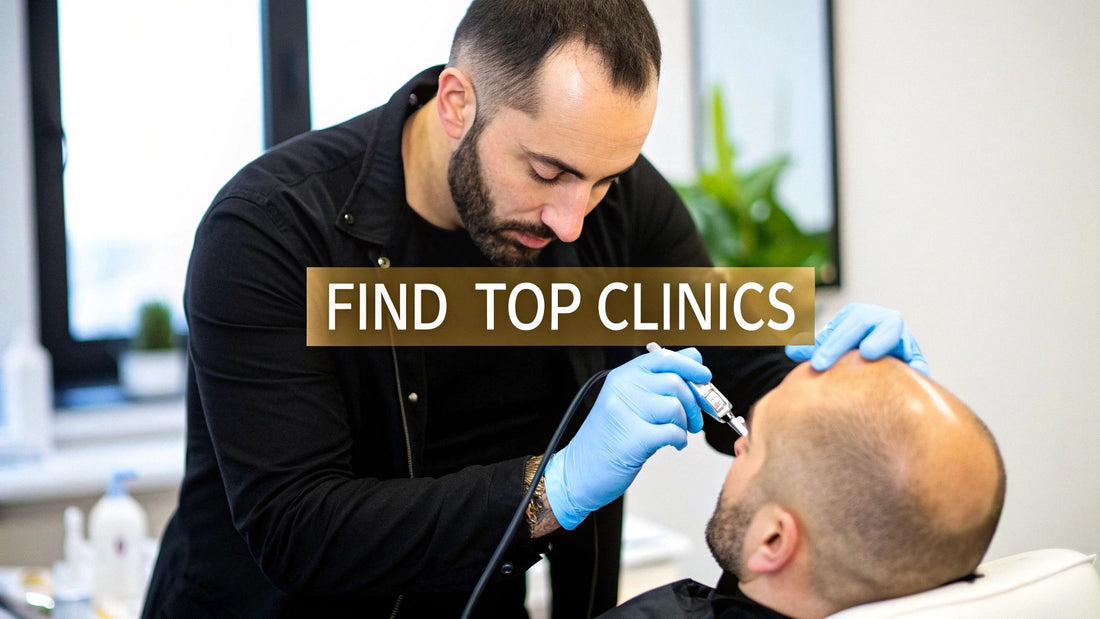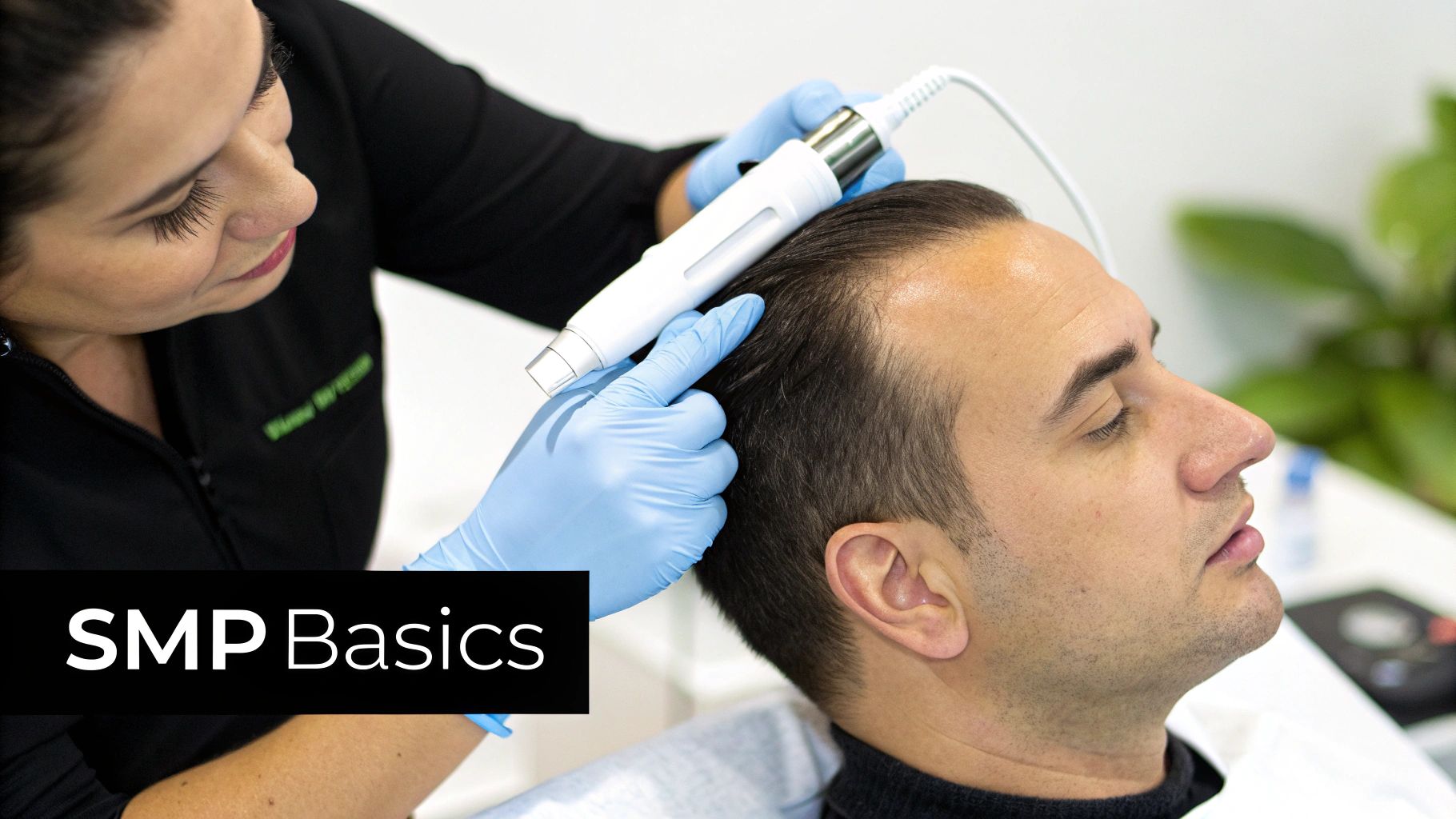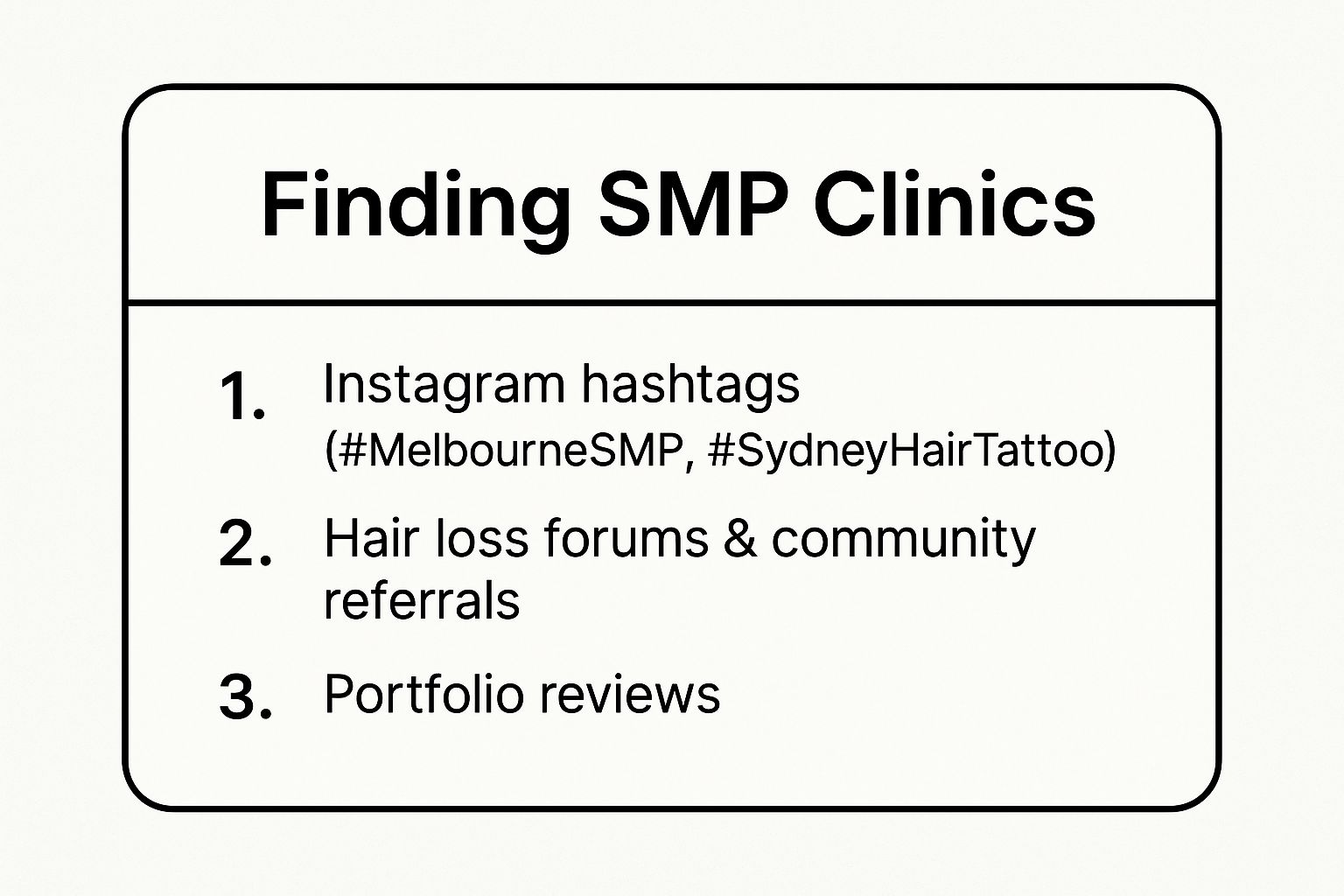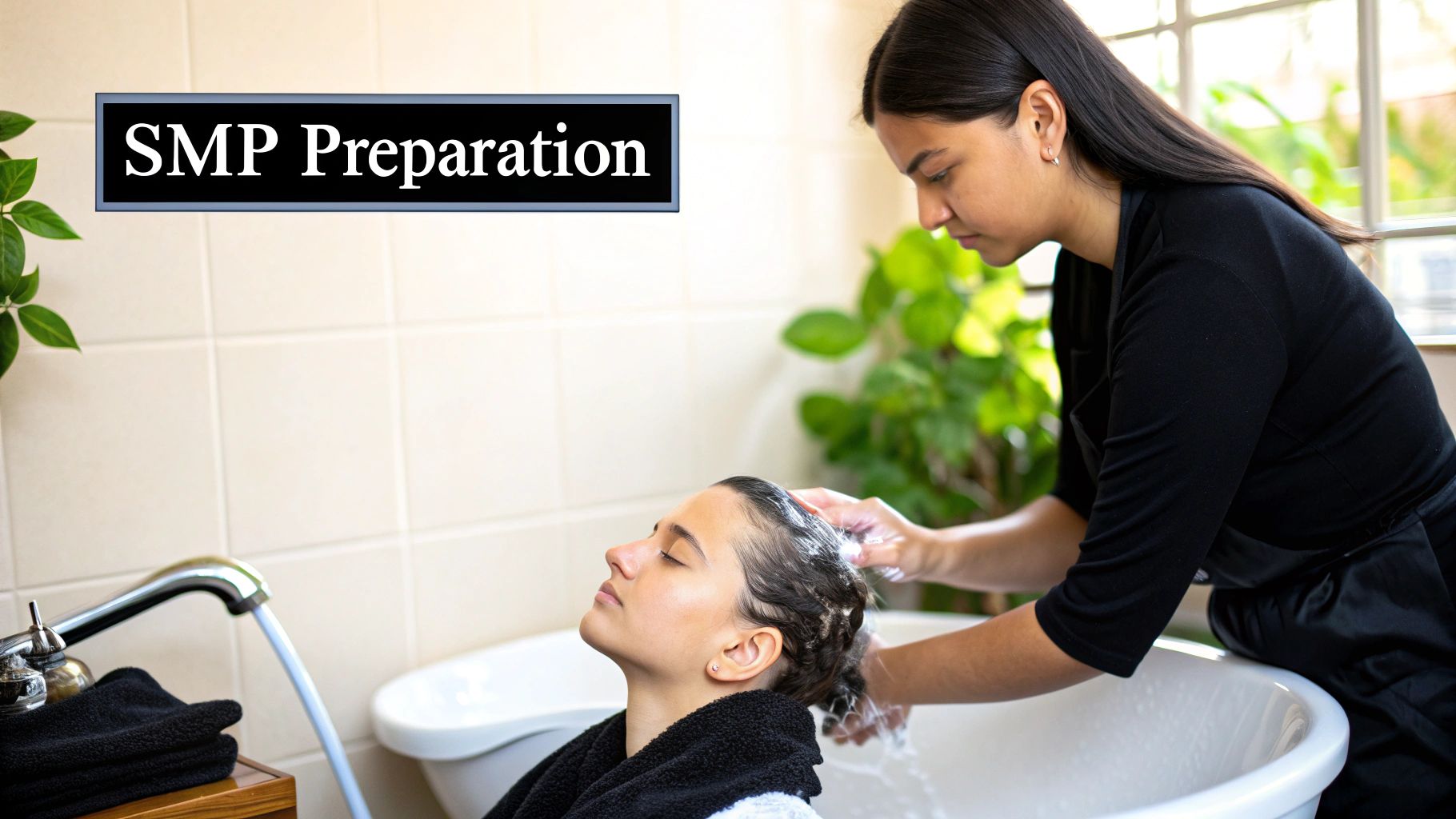
Micro Scalp Pigmentation Near Me in Australia – Find Top Clinics
Share
Before you even start Googling "scalp micropigmentation near me," it's crucial to get your head around what the treatment actually is. Think of it less as a tattoo and more as a highly specialised cosmetic procedure. It’s an art form that uses tiny needles to create the illusion of thousands of individual hair follicles, giving you a non-surgical answer to hair loss.
So, What Is Scalp Micropigmentation and Why Is Everyone Talking About It?

Let's get clear on the fundamentals. Scalp micropigmentation, or SMP, isn't your standard trip to the tattoo parlour. It’s an incredibly precise technique that mimics the look of a full, freshly buzzed head of hair. A skilled artist deposits specialised pigments into the upper layer of the scalp, dot by tiny dot, meticulously matching the colour and density to blend with any existing hair.
The procedure has really taken off across Australia, and for good reason. It delivers immediate, predictable results. You walk out of your final session with a new look, unlike hair growth treatments that can take months to work—if they work at all. Plus, because it’s non-invasive, you can forget about surgery, scars, and lengthy downtime.
Here in Australia, demand has exploded, particularly in cities like Sydney and Melbourne. We’re now seeing hundreds of these procedures done every month in the major hubs, with the industry experiencing an estimated 15-20% growth in recent years. This non-surgical cosmetic tattooing technique uses microneedles to deposit pigment into the scalp, creating the illusion of a fuller head of hair, often styled as a close buzz cut. To learn more about this growth in Australia, you can explore detailed insights about the local SMP market.
What’s Really Driving the SMP Boom?
So what makes SMP the go-to for so many people dealing with hair loss? The benefits are tangible, tackling both the visual side of hair loss and the practicalities of everyday life.
- A Master of Disguise: SMP is brilliant at camouflaging all sorts of hair loss, from a slightly receding hairline and general thinning to more widespread baldness.
- Hiding Scars: It's a game-changer for concealing scars from old hair transplant surgeries (both FUE and FUT), accidents, or other injuries, making them blend seamlessly into the scalp.
- Confidence, Restored: Honestly, this is the big one. The psychological lift you get from a restored hairline and the look of a full head of hair can be incredible for your self-esteem.
- Seriously Low Maintenance: Once your sessions are done and the scalp has healed, SMP is incredibly easy to live with. No special shampoos, no daily lotions—just common-sense sun protection.
Understanding these core principles and benefits is the first real step. It arms you with the knowledge to find a practitioner who can deliver the natural, seamless result you’re looking for and helps you make a truly informed choice.
Ultimately, knowing what's involved in scalp micropigmentation shifts your search from a simple query into a focused mission. You can dive deeper by checking out our complete guide on what scalp micropigmentation is. This background knowledge will help you ask the right questions and judge clinics based on what truly matters for a world-class result.
How to Find a Reputable SMP Clinic in Your Area
When you first type "micro scalp pigmentation near me" into Google, it's easy to get overwhelmed. The clinics that pop up first often just have the biggest marketing budgets, not necessarily the best artists. To find a truly skilled practitioner, you need to look past the sponsored ads and dig into real-world results and honest community feedback.
A great starting point is to switch from traditional search engines to visual platforms where the work speaks for itself. Instagram is an absolute goldmine for this. Forget generic searches and get specific with hashtags like #MelbourneSMP or #SydneyHairTattoo. This cuts through the noise and lets you see an artist’s fresh work, their signature style, and, most importantly, how their treatments look once they've healed.
Moving from Search Results to Real Results
Another fantastic resource is the world of online communities and hair loss forums. This is where you'll find unfiltered, brutally honest conversations from people who have already been through the entire SMP process. They'll share their stories, post their own progress photos, and recommend (or warn you about) specific artists. This kind of firsthand insight is invaluable and can often lead you to hidden gems you'd never find on the first page of Google.
When you're sifting through local listings, it helps to understand what you're looking at. Knowing a bit about how local businesses can rank on Google Maps and win local search can help you spot the genuinely well-regarded local clinics from those who are just good at digital marketing.
This infographic breaks down the most effective ways to build your initial shortlist of potential SMP clinics.

This method shifts your focus from slick websites to tangible proof and authentic recommendations. Ultimately, your goal here is to build a solid list of 3-5 promising clinics. These should be artists whose work you genuinely admire and who have a track record of happy, real-world clients.
Your initial search isn't about choosing a clinic—it's about gathering high-quality candidates. Focus on finding artists whose healed work consistently impresses you and whose reputation is backed by real people.
As you build this shortlist, keep a running log of each clinic's portfolio and any standout testimonials you come across. Getting organised now will make the next step—the deep-dive vetting process—so much easier. For a more detailed look at the local landscape, our guide on scalp micropigmentation in Australia offers plenty of context that will help you evaluate your options.
What to Look For in an SMP Artist and Clinic

You’ve got a shortlist of local clinics from your "micro scalp pigmentation near me" search. Now for the most important part. This is where you dig deeper than the flashy marketing and learn to spot genuine skill and professionalism. The final result rests entirely on the artist's hands and the standards of their clinic.
Your first job is to become a portfolio detective. Don't just flick through the before-and-afters; you need to properly scrutinise them. Look for high-resolution photos and videos, and specifically hunt down healed results—not just pictures taken right after a session when the scalp is still fresh and red.
Fresh work can look great initially but can also be deceiving. It's the healed photos, taken weeks or even months later, that reveal the artist's true talent. This is how you see if the pigment has settled correctly and if the look is truly natural and undetectable.
Decoding an Artist's Portfolio
A top-tier SMP artist leaves tell-tale signs of quality in their work. Knowing what these are will help you tell a master from an amateur. A great portfolio isn't just about filling in bald spots; it’s about creating a hyper-realistic illusion of hair. While it's from a different field, this guidance on selecting a professional firm has some great universal principles for judging any specialised service provider.
When you're looking through their gallery, keep an eye out for these crucial details:
- Seamless Blending: The SMP work should melt into any existing hair. You shouldn't be able to see a clear line where the treatment begins or ends.
- Natural Hairlines: A dead giveaway of amateur work is a bad hairline. Look for soft, slightly varied hairlines that are appropriate for the client’s age. A razor-sharp, perfect line on a 50-year-old just screams fake.
- Follicle Realism: Real hair follicles aren't all the same size or shade, and neither should the SMP impressions be. They should have subtle variations. Dots that are too big, too dark, or too uniform create that dreaded "helmet" look.
- Colour Matching: The pigment has to be a perfect match for the client's hair and skin tone. The goal is to create a soft, shadowy effect that mimics real density.
The whole point of scalp micropigmentation is for it to go unnoticed. The very best work is so natural that nobody would ever guess it's a treatment. If a portfolio makes you think, "that's a good hair tattoo," the artist has actually missed the mark.
Clinic Standards and Professionalism
Beyond the portfolio, the clinic itself needs to be held to a high standard. This isn't just a simple cosmetic treatment; it's a procedure where the skin is being broken. Hygiene is absolutely non-negotiable.
SMP has exploded in popularity across Australia, mirroring a global trend. The worldwide scalp micropigmentation market was valued at around USD 1.21 billion and is only expected to keep growing. That growth means new clinics are popping up all the time, which makes it even more vital to check their credentials and hygiene practices.
A professional clinic will always use single-use needles, maintain a sterile environment, and only use high-quality pigments specifically made for SMP. Don't be shy—ask to see their certifications and proof of insurance. Any reputable clinic will be happy to show you. This meticulous approach is a key part of what makes the procedure a success, a topic we dive into in our ultimate guide to the hair tattoo solution. A trustworthy artist will be proud to show off their clean, organised workspace and answer all your questions about safety protocols.
Key Vetting Criteria For Your Local SMP Clinic
To help you stay organised, use this checklist to systematically evaluate and compare the clinics on your shortlist. It's an easy way to make sure you're covering all the essential quality and safety checks without missing anything.
| Criteria | What to Look For | Red Flags to Avoid |
|---|---|---|
| Portfolio Quality | High-resolution photos, plenty of healed results, videos showing 360-degree views, diverse client examples (skin tones, hair colours). | Only fresh work, blurry/low-quality images, limited examples, unnatural-looking results. |
| Artist Experience | Specialises in SMP (not just a side service), has several years of dedicated experience, can show proof of training and certification. | New to the industry, offers a huge menu of unrelated services, vague about their training background. |
| Clinic Hygiene | Spotlessly clean treatment room, single-use needles opened in front of you, proper disposal bins, clean and organised workspace. | Cluttered or dirty environment, reusing equipment, unwillingness to discuss safety protocols. |
| Consultation Process | In-depth, personalised discussion about your goals, provides a clear treatment plan, answers all questions patiently and honestly. | Rushed consultation, high-pressure sales tactics, one-size-fits-all approach, evading questions. |
| Reviews & Reputation | Consistent positive reviews on multiple platforms (Google, social media), testimonials with photos, good word-of-mouth in the community. | No reviews or only a few generic ones, negative feedback about results or professionalism, a non-existent online presence. |
Using a structured approach like this takes the guesswork out of the process. It helps you move from an emotional decision to a logical one, ensuring you end up with an artist and clinic you can trust completely.
Asking the Right Questions During Your Consultation
You’ve done your homework, scoured the web for "scalp micropigmentation near me," and have a shortlist of promising clinics. Now for the most important step: the consultation. This isn't just a sales pitch; it's your opportunity to interview the artist and see if their skills, artistic eye, and professionalism really match what you're looking for.
Walking into this meeting prepared is key. Moving beyond a simple "how much does it cost?" will uncover the true depth of an artist's expertise and their dedication to getting your result just right. Think of this conversation as the final piece of the puzzle, making sure there are no surprises down the track.
Questions About the Artist and Their Technique
First things first, you need to dig into the artist's hands-on experience and their creative approach. Their answers will speak volumes about how they see their craft and whether they’re the right person to handle your specific needs, like your skin tone or the hairline style you have in mind. A genuinely passionate artist will love answering these detailed questions.
Here are a few essential things to ask:
- Experience with Your Profile: Don't be shy. Ask directly, "How many clients have you worked on with my hair colour and skin tone?" An artist who excels with fair skin and lighter hair might not have the same level of experience with darker skin tones, and the reverse is also true.
- Hairline Design Philosophy: This is a big one. Get them to walk you through their process for creating a natural-looking hairline. You want to hear them talk about crafting a soft, subtly imperfect line that’s age-appropriate—not a harsh, razor-sharp edge that screams "tattoo."
- Pigment and Equipment: Ask what kind of pigments they use. The answer should be high-quality, stable pigments made specifically for SMP. Standard tattoo ink is a major red flag, as it can fade to blue or green over time.
A great artist should be eager to show you photos of healed work on clients who have similar features to you. This is so much more telling than seeing a fresh treatment, as it reveals how the pigment truly settles into the skin for the long haul.
Your consultation is more than just getting a price quote; it’s a vibe check. Do you feel like they're actually listening? Or are they just pushing a one-size-fits-all solution? Trust your gut.
Understanding the Treatment Plan and Logistics
Once you feel confident in their skill, it’s time to get down to the practical details. Any professional clinic will be completely transparent about the entire process, from your first session right through to long-term care. You don't want any surprises when it comes to a procedure like this.
Make sure you get clear answers on these points:
- Number of Sessions: Ask for a realistic estimate of how many sessions you’ll need. For most people, a full treatment takes between 2-4 sessions to build up the perfect density and blend everything seamlessly.
- Pain Management: What do they do to manage discomfort? While most clients say it’s not very painful, a good clinic will offer topical numbing creams to keep you as comfortable as possible.
- Patch Test: A reputable clinic should always offer a patch test. This is just a small, discreet test to make sure you won’t have an allergic reaction to the pigment. It's a simple but critical safety step.
- Long-Term Care: What happens in a few years? SMP can fade slightly over 4-6 years, so ask about their policy on future touch-ups. Knowing the cost and process for maintenance helps you plan for the future.
Getting these questions answered will give you the confidence to make an informed decision, ensuring the clinic you choose is the right partner for your journey.
Making a Confident Choice and Preparing for Treatment

You've done the hard yards. You’ve sifted through countless "micro scalp pigmentation near me" results, scrutinised portfolios, and sat through consultations. Now, with a couple of top contenders on your list, it's time to make the final call.
This isn’t a decision to be made on price or location alone. It’s about weighing up everything you’ve learned and, just as importantly, trusting your gut. Think back to the consultations. Did one artist just get the look you were after? Did one clinic feel more professional and put you at ease? Those gut feelings are often right.
At this stage, it all comes down to trust. You need to feel 100% confident in the artist's ability and completely comfortable with the plan they've laid out. Any nagging doubt is a red flag telling you to pause.
Finalising Your Decision
It can help to lay everything out side-by-side. Put the details for your top two choices on paper and compare them directly—the quality of their healed work, how clearly they answered your questions, and the overall vibe of their clinic. Stepping back and looking at the whole picture often makes the right choice obvious.
The SMP industry in Australia is booming, with incredible artists and techniques emerging all the time. This growth makes it even more crucial to choose a provider who prioritises safety and consistently delivers quality results.
Once you've made your decision and locked in that first appointment, the excitement really starts to build. The focus now shifts to getting yourself ready, because proper preparation is key to a fantastic outcome. Following your clinic's advice ensures your scalp is the perfect canvas for the artist to work their magic.
How to Prepare for Your First SMP Session
Getting ready for your treatment is pretty simple, but it’s a non-negotiable part of the process. Good prep work can help minimise any discomfort during the session and ensures the pigment settles perfectly, laying the groundwork for a flawless, long-lasting result.
Here are the main things you’ll need to do in the days before you head into the clinic:
- Stay Out of the Sun: For at least a week before your session, keep your scalp covered. A sunburnt scalp is sensitive, inflamed, and not something an artist can work on effectively.
- Moisturise, Moisturise, Moisturise: Get into the habit of applying a basic, unscented moisturiser to your scalp daily for a week leading up to the treatment. Well-hydrated skin accepts the pigment so much better.
- Avoid Alcohol and Blood Thinners: Steer clear of alcohol and medications like aspirin for at least 24-48 hours beforehand. They can thin the blood, which may lead to more bleeding and affect how well the pigment holds.
- Get That Final Haircut: If you’re going for the classic buzz-cut look, get your hair trimmed to the length you’ll be keeping it a day or two before your appointment. This gives the artist the perfect guide for blending the SMP seamlessly with your natural hair.
These small steps make a huge difference. For a more in-depth guide, we’ve put together a full rundown on how to prepare for scalp micropigmentation treatment. Walking in fully prepared not only helps your artist but also ensures you start your SMP journey off on the best possible foot.
Answering Your Final SMP Questions
As you get closer to making a decision, a few key questions are probably on your mind. When people search for "micro scalp pigmentation near me," they almost always want to know about three things: the cost, the comfort level, and how long it all lasts. Getting clear answers here is the final step to feeling 100% confident in your choice.
What’s the Real Cost of Scalp Micropigmentation in Australia?
There’s no single price tag for SMP in Australia. The final investment really comes down to the extent of your hair loss, the clinic's reputation, and where it’s located.
Generally, a full treatment course of 2-4 sessions can run anywhere from about $1,200 for smaller jobs like scar camouflage up to $4,000+ for full scalp coverage.
It’s also true that clinics in big cities like Sydney or Melbourne might charge a bit more. This is exactly why that in-person consultation is non-negotiable—it’s the only way for an artist to properly assess what you need and give you a precise quote with no nasty surprises. For a more thorough look at the numbers, check out our guide on micro scalp pigmentation costs.
Does the Scalp Micropigmentation Procedure Actually Hurt?
This is the big one, and the answer usually puts people at ease. Most clients tell us the feeling is a minor, repetitive pricking sensation. On a pain scale, they typically rate it a 2-4 out of 10.
It’s far less intense than getting a regular tattoo because the needles are only working on the very top layers of your skin. Plus, any good technician will apply a topical numbing cream to your scalp before starting, just to make sure you’re comfortable throughout the session.
You’ll be glad to know downtime is practically zero. Most people are back to their normal routine the next day. The only real rules are to avoid heavy sweating, swimming, and direct sun on your scalp for about a week. This gives the pigment the best chance to settle in perfectly.
How Long Does SMP Last Before I Need a Touch-Up?
Scalp micropigmentation is built to last. While we call it a permanent solution, the pigment will very gradually lighten over many years. This is a natural process caused by skin exfoliation and, most importantly, sun exposure.
To keep your SMP looking crisp and dense, most clients pop back in for a simple touch-up session every 4 to 6 years. The best way to push that timeline out even further is to be smart about sun protection. A high-SPF sunscreen on your scalp whenever you’re outdoors will make a massive difference in preserving your results for years to come.
At My Transformation, we believe in giving you clear, honest answers and delivering world-class results that bring back your confidence. If you’re ready to see what’s possible, visit us online to book your free consultation and let's talk about your hair goals.
